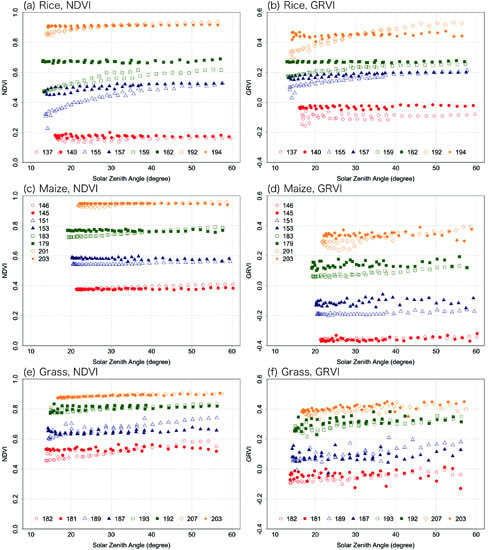The Impact of Sunlight Conditions on the Consistency of Vegetation Indices in Croplands—Effective Usage of Vegetation Indices from Continuous Ground-Based Spectral Measurements
Abstract
:1. Introduction
2. Materials and Methods
2.1. Study Sites
| Rice | Maize | Grass | |
|---|---|---|---|
| Site code | MSE | SHD | NSS |
| Position | 36°03'14.3"N, 140°01'36.9"E | 42°24'41.4"N, 142°28'16.6"E | 36°54'54.3"N, 139°56'12.8"E |
| Elevation (m asl) | 11 | 120–130 | 305 |
| Mean annual air temperature (°C) | 13.7 | 8.0 | 12.2 |
| Mean annual precipitation (mm) | 1200 | 1290 | 1561 |
| Vegetation type | Paddy field | Upland field | Cultivated grassland |
| Dominant species | Rice (Oryza sativa L.; cultivar Koshihikari) | Maize (Zea mays L.) | Orchardgrass (Dactylis glomerata L.), Italian lyegrass (Lolium multiflorum Lam.) |
| Canopy height (m) | 0–1.2 | 0–3.2 | 0–1.2 |
| Annual maximum leaf area index (m2·m−2) | 5.0 | NA | NA |
| Height of sensor arm (m) | 2.88 | 5.15 | 1.55 |
| Data logger | CR3000 | CR23X | CR23X |
| Observation year | 2013 | 2013 | 2014 |
| Growth stage | Transplanting: DOY 122 (2 May) Heading: DOY 204 (23 Jul.) Harvesting: DOY 249 (6 Sep.) | Budding: DOY 150 (30 May) Silking: Dot 208 (27 Jul.) Harvesting: DOY 261 (18 Sep.) | Second Harvesting: DOY 178 (27 Jun.) Third harvesting: DOY 239 (27 Aug.) |
2.2. Data and Analytical Methods
2.2.1. Multispectral Radiance Measurement
2.2.2. Vegetation Indices Based on Ground-Based Spectral Measurements
2.2.3. A Radiative Transfer Model for Simulating Vegetation Indices
| Parameter | Value |
|---|---|
| Chlorophyll a and b content (Cab) | 40 |
| Carotenoid content (Car) | 12.3 |
| Brown pigment content (Cbrown) | 0 |
| Leaf water content (Cw) | 0.015 |
| Leaf dry matter content (Cm) | 0.0055 |
| Structure coefficient (N) | 1.5 |
| Leaf angle distribution (LIDF) | Spherical |
| Leaf area index (LAI) | 0.1, 0.5, 1, 2, 3, 4, 5 |
| Solar zenith angle (tts) | 20, 30, 40, 50, 60 |
| Observer zenith angle (tto) | 0 |
| Azimuth (psi) | 0 |
| Soil reflectance properties (psoil) | 0.7 |
3. Results
3.1. The Effects of Solar Zenith Angle on Diurnal and Seasonal Change of Vegetation Indices

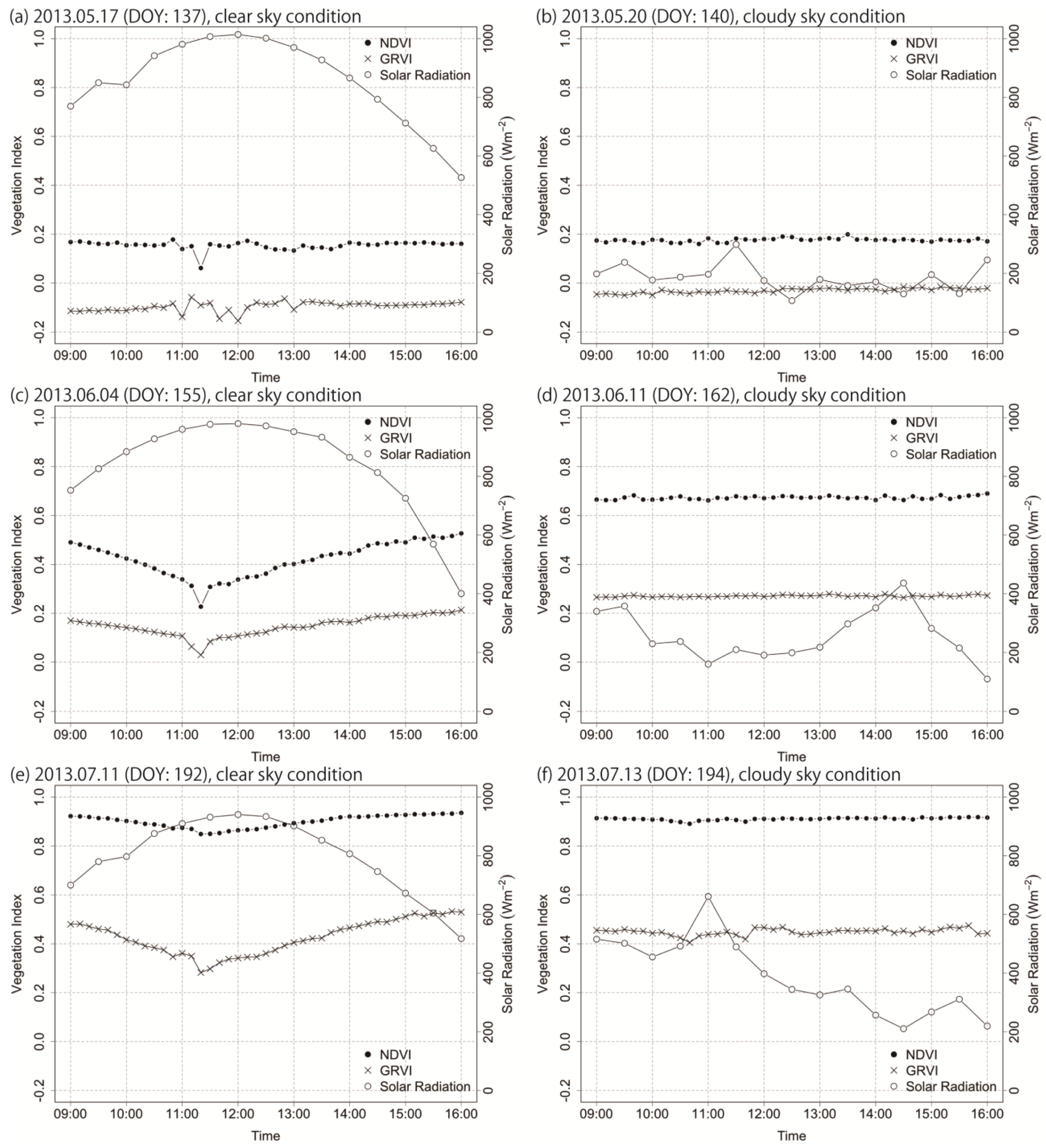

| Rice | Maize | Grass | |||||||||
|---|---|---|---|---|---|---|---|---|---|---|---|
| DOY | Slope | Intercept | R2 | DOY | Slope | Intercept | R2 | DOY | Slope | Intercept | R2 |
| 137 | 0.0005 | 0.140 | 0.111 | 146 | 0.0009 | 0.357 | 0.799 | 182 | 0.0029 | 0.426 | 0.855 |
| 140 | −0.00003 | 0.176 | 0.003 | 145 | 0.0002 | 0.371 | 0.295 | 181 | 0.0003 | 0.524 | 0.092 |
| 155 | 0.0050 | 0.274 | 0.847 | 151 | 0.0005 | 0.530 | 0.869 | 189 | 0.0029 | 0.585 | 0.775 |
| 157 | 0.0015 | 0.455 | 0.642 | 153 | −0.0003 | 0.590 | 0.215 | 187 | 0.0004 | 0.634 | 0.207 |
| 159 | 0.0034 | 0.449 | 0.829 | 183 | 0.0019 | 0.686 | 0.987 | 193 | 0.0012 | 0.766 | 0.798 |
| 162 | 0.0001 | 0.669 | 0.047 | 179 | −0.0001 | 0.772 | 0.102 | 192 | 0.0006 | 0.789 | 0.219 |
| 192 | 0.0019 | 0.844 | 0.856 | 201 | 0.0008 | 0.916 | 0.707 | 207 | 0.0008 | 0.865 | 0.897 |
| 194 | 0.0003 | 0.903 | 0.364 | 203 | −0.00007 | 0.950 | 0.161 | 203 | 0.0007 | 0.867 | 0.831 |
| (b) GRVI | |||||||||||
| Rice | Maize | Grass | |||||||||
| DOY | Slope | Intercept | R2 | DOY | Slope | Intercept | R2 | DOY | Slope | Intercept | R2 |
| 137 | 0.0004 | −0.109 | 0.072 | 146 | 0.0005 | −0.370 | 0.609 | 182 | 0.0016 | −0.105 | 0.636 |
| 140 | 0.0003 | −0.041 | 0.173 | 145 | 0.0006 | −0.378 | 0.290 | 181 | −0.0001 | −0.039 | 0.002 |
| 155 | 0.0028 | 0.065 | 0.831 | 151 | 0.0007 | −0.207 | 0.628 | 189 | 0.0031 | 0.010 | 0.603 |
| 157 | 0.0010 | 0.154 | 0.680 | 153 | 0.0005 | −0.126 | 0.072 | 187 | 0.0003 | 0.076 | 0.014 |
| 159 | 0.0020 | 0.159 | 0.863 | 183 | 0.0018 | 0.023 | 0.921 | 193 | 0.0019 | 0.233 | 0.651 |
| 162 | 0.00004 | 0.269 | 0.019 | 179 | 0.0006 | 0.123 | 0.097 | 192 | 0.0014 | 0.272 | 0.242 |
| 192 | 0.0054 | 0.270 | 0.912 | 201 | 0.0032 | 0.204 | 0.749 | 207 | 0.0014 | 0.346 | 0.470 |
| 194 | 0.0004 | 0.438 | 0.115 | 203 | 0.0001 | 0.337 | 0.004 | 203 | 0.0013 | 0.371 | 0.412 |
3.2. Vegetation Indices Simulated Using the Radiative Transfer Model
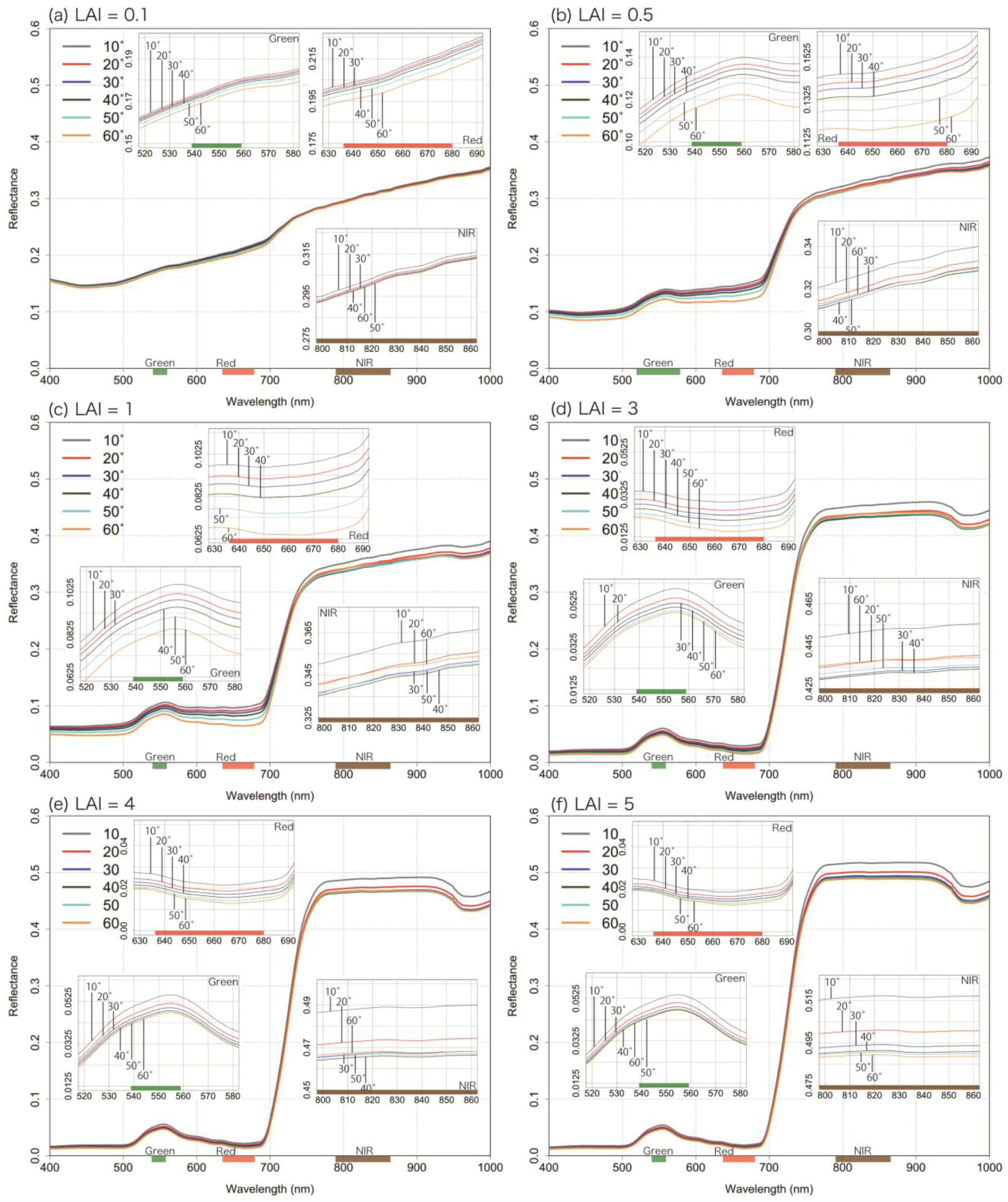
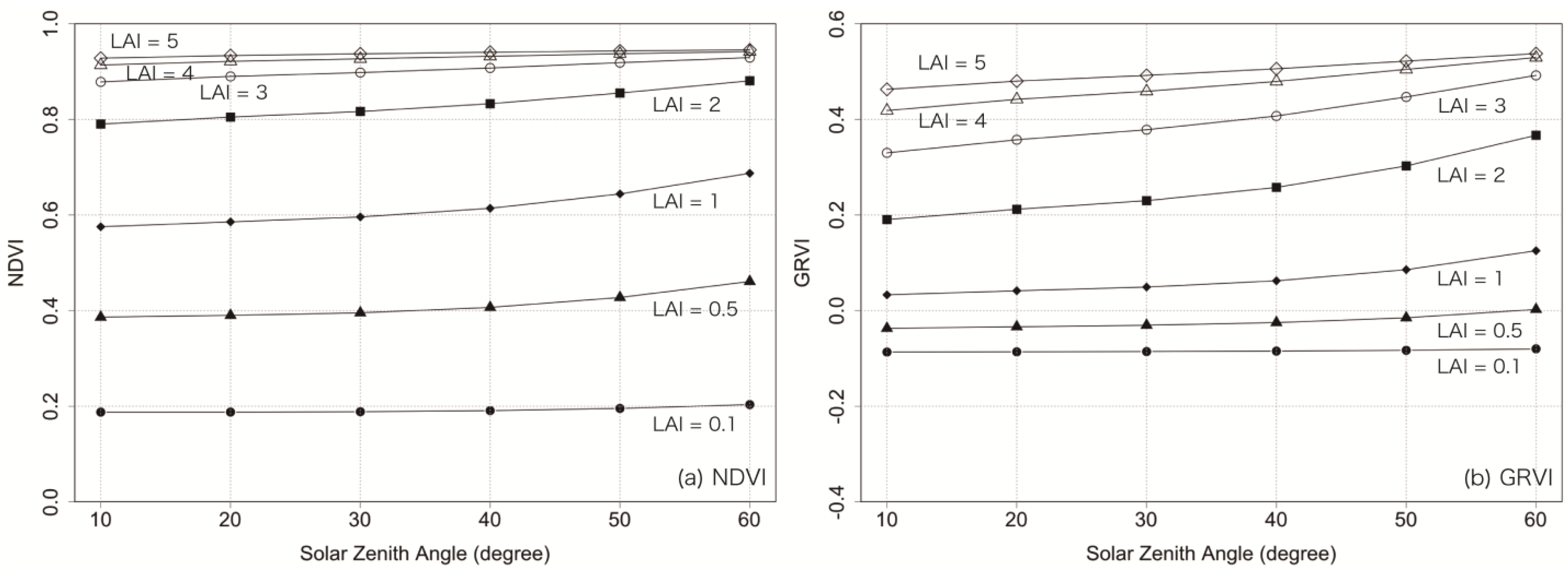
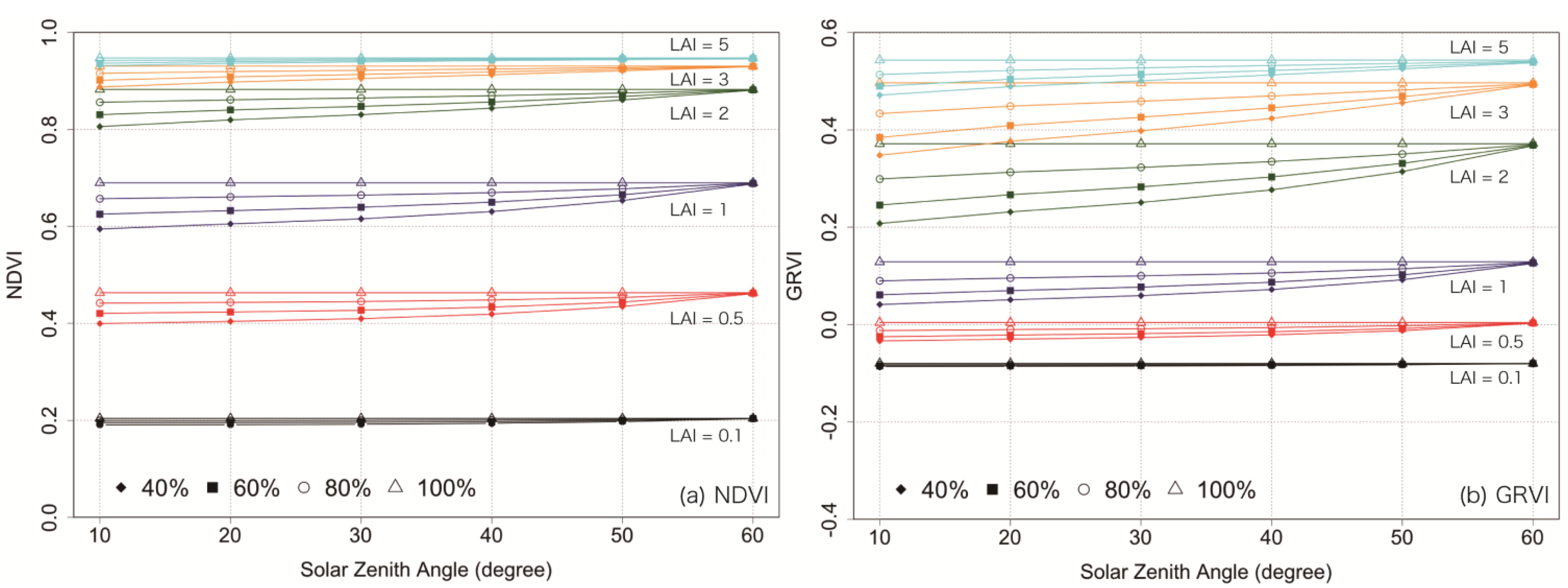
4. Discussion
4.1. Influence of the Solar Zenith Angle on the Change in Vegetation Indices
4.2. Response of Vegetation Indices to Solar Zenith Angle and Diffuse/Direct Light Conditions in Different Vegetation Types
4.3. Effective Usage of Vegetation Indices Derived from Continuous Ground-Based Spectral Measurement
5. Conclusions
Acknowledgments
Author Contributions
Conflicts of Interest
References
- Hatfield, J.L.; Gitelson, A.A.; Schepers, J.S.; Walthall, C.L. Application of spectral remote sensing for agronomic decisions. Agron. J. 2008, 100, 117–131. [Google Scholar]
- Inoue, Y.; Sakaiya, E.; Zhu, Y.; Takahashi, W. Diagnostic mapping of canopy nitrogen content in rice based on hyperspectral measurements. Remote Sens. Environ. 2012, 126, 210–221. [Google Scholar] [CrossRef]
- Peng, Y.; Gitelson, A.; Sakamoto, T. Remote estimation of gross primary productivity in crops using MODIS 250 m data. Remote Sens. Environ. 2013, 128, 186–196. [Google Scholar] [CrossRef]
- Zhong, L.; Gong, P.; Biging, G.S. Efficient corn and soybean mapping with temporal extendability: A multi-year experiment using Landsat imagery. Remote Sens. Environ. 2014, 140, 1–13. [Google Scholar] [CrossRef]
- Asaka, D.; Shiga, H. Estimating rice grain protein contents with SPOT/HRV data acquired at maturing stage. J. Remote Sens. Soc. Jpn. 2003, 23, 451–457, (In Japanese with English summary). [Google Scholar]
- Sakaiya, E.; Inoue, Y. Operational use of remote sensing for harvest management of rice. J. Remote Sens. Soc. Jpn. 2013, 33, 185–199, (In Japanese with English summary). [Google Scholar]
- Wang, J.; Huang, J.; Zhang, K.; Li, X.; She, B.; Wei, C.; Gao, J.; Song, X. Rice fields mapping in fragmented area using multi-temporal HJ-1A/B CCD images. Remote Sens. 2015, 7, 3467–3488. [Google Scholar] [CrossRef]
- Inoue, Y.; Sakaiya, E. Relationship between X-band backscattering coefficients from high-resolution satellite SAR and biophysical variables in paddy rice. Remote Sens. Lett. 2013, 4, 288–295. [Google Scholar] [CrossRef]
- Inoue, Y.; Sakaiya, E.; Wang, C. Potential of X-band images from high-resolution satellite SAR sensors to assess growth and yield in paddy rice. Remote Sens. 2014, 6, 5995–6019. [Google Scholar] [CrossRef]
- Inoue, Y.; Sakaiya, E.; Wang, C. Capability of C-band backscattering coefficients from high-resolution satellite SAR sensors to assess biophysical variables in paddy rice. Remote Sens. Environ. 2014, 140, 257–266. [Google Scholar] [CrossRef]
- Hunt, E.R.; Hively, W.D.; Fujikawa, S.J.; Linden, D.S.; David, S.C.; Daughtry, S.T.; McCarty, G.W. Acquisition of NIR-green-blue digital photographs from unmanned aircraft for crop monitoring. Remote Sens. 2010, 2, 290–305. [Google Scholar] [CrossRef]
- Duan, S.B.; Li, Z.L.; Wu, H.; Tang, B.H.; Ma, L.; Zhao, E.; Li, C. Inversion of the PROSAIL model to estimate leaf area index of maize, potato, and sunflower fields from unmanned aerial vehicle hyperspectral data. Int. J. Appl. Earth Obs. Geoinf. 2014, 26, 12–20. [Google Scholar] [CrossRef]
- Balzarolo, M.; Anderson, K.; Nichol, C.; Rossini, M.; Vescovo, L.; Arriga, N.; Wohlfahrt, G.; Calvet, J.-C.; Carrara, A.; Cerasoli, S.; et al. Ground-based optical measurements at European flux sites: A review of methods, instruments and current controversies. Sensors 2011, 11, 7954–7981. [Google Scholar] [CrossRef] [PubMed]
- Gamon, J.A.; Rahman, A.F.; Dungan, J.L.; Schildhauer, M.; Huemmrich, K.F. Spectral Network (SpecNet): What is it and why do we need it? Remote Sens. Environ. 2006, 103, 227–235. [Google Scholar] [CrossRef]
- Nasahara, K.N.; Nagai, S. Review: Development of an in situ observation network for terrestrial ecological remote sensing: the Phenological Eyes Network (PEN). Ecol. Res. 2015, 30, 211–223. [Google Scholar] [CrossRef]
- Soudani, K.; Hmimina, G.; Delpierre, N.; Pontailler, J.Y.; Aubinet, M.; Bonal, D.; Caquet, B.; de Grandcourt, A.; Burban, B.; Flechard, C.; et al. Ground-based Network of NDVI measurements for tracking temporal dynamics of canopy structure and vegetation phenology in different biomes. Remote Sens. Environ. 2012, 123, 234–245. [Google Scholar] [CrossRef]
- Motohka, T.; Nasahara, K.N.; Miyata, A.; Mano, M.; Tsuchida, S. Evaluation of optical satellite remote sensing for rice paddy phenology in monsoon Asia using a continuous in situ dataset. Int. J. Remote Sens. 2009, 30, 4343–4357. [Google Scholar] [CrossRef]
- Sakamoto, T.; Gitelson, A.A.; Nguy-Robertson, A.L.; Arkebauer, T.J.; Wardlow, B.D.; Suyker, A.E.; Verma, S.B.; Shibayama, M. An alternative method using digital cameras for continuous monitoring of crop status. Agric. For. Meteorol. 2012, 154–155, 113–126. [Google Scholar] [CrossRef]
- Schaaf, C.B.; Gao, F.; Strahler, A.H.; Lucht, W.; Li, X.; Tsang, T.; Strugnell, N.C.; Zhang, X.; Jin, Y.; Muller, J.P.; et al. First operational BRDF, Albedo and Nadir reflectance products from MODIS. Remote Sens. Environ. 2002, 83, 135–148. [Google Scholar] [CrossRef]
- Motohka, T.; Nasahara, K.N.; Oguma, H.; Tsuchida, S. Applicability of green-red vegetation index for remote sensing of vegetation phenology. Remote Sens. 2010, 2, 2369–2387. [Google Scholar] [CrossRef]
- Nagai, S.; Saitoh, T.M.; Kobayashi, H.; Ishihara, M.; Suzuki, R.; Motohka, T.; Nasahara, K.N.; Muraoka, H. In situ examination of the relationship between various vegetation indices and canopy phenology in an evergreen coniferous forest, Japan. Int. J. Remote Sens. 2012, 33, 6202–6214. [Google Scholar] [CrossRef]
- Cogliati, S.; Rossini, M.; Julitta, T.; Meroni, M.; Schickling, A.; Burkart, A.; Pinto, F.; Rascher, U.; Colombo, R. Continuous and long-term measurements of reflectance and sun-induced chlorophyll fluorescence by using novel automated field spectroscopy systems. Remote Sens. Environ. 2015, 164, 270–281. [Google Scholar] [CrossRef]
- Rahman, M.M.; Lamb, D.W.; Stanley, J.N. The impact of solar illumination angle when using active optical sensing of NDVI to infer fAPAR in a pasture canopy. Agric. For. Meteorol. 2015, 202, 39–43. [Google Scholar] [CrossRef]
- Tucker, C.J. Red and photographic infrared linear combinations for monitoring vegetation. Remote Sens. Environ. 1979, 8, 127–150. [Google Scholar] [CrossRef]
- Baez-Gonzalez, A.D.; Kiniry, J.R.; Maas, S.J.; Tiscareno, M.L.; Macias, J.C.; Mendoza, J.L.; Richardso, C.W.; Salinas, J.G.; Manjarrez, J.R. Large-area maize yield forecasting using leaf area index based yield model. Agron. J. 2005, 97, 418–425. [Google Scholar] [CrossRef]
- Funk, C.; Budde, M. Phenologically-tuned MODIS NDVI-based production anomaly estimates for Zimbabwe. Remote Sens. Environ. 2009, 113, 115–125. [Google Scholar] [CrossRef]
- Nagai, S.; Ishii, R.; Suhaili, A.B.; Kobayashi, H.; Matsuoka, M.; Ichie, T.; Motohka, T.; Kendawang, J.J.; Suzuki, R. Usability of noise-free daily satellite-observed green-red vegetation index values for monitoring ecosystem changes in Borneo. Int. J. Remote Sens. 2014, 35, 7910–7926. [Google Scholar] [CrossRef]
- Nkongolo, N.V.; Hatano, R.; Kakembo, V. Diffusivity models and greenhouse gases fluxes from a forest, pasture, grassland and corn field in Northern Hokkaido, Japan. Pedosphere 2010, 20, 747–760. [Google Scholar] [CrossRef]
- Ono, K.; Maruyama, A.; Kuwagata, T.; Mano, M.; Takimoto, T.; Hayashi, K.; Hasegawa, T.; Miyata, A. Canopy-scale relationships between stomatal conductance and photosynthesis in irrigated rice. Glob. Change Biol. 2013, 19, 2209–2220. [Google Scholar] [CrossRef] [PubMed]
- Matsuura, S.; Miyata, A.; Mano, M.; Hojito, M.; Mori, A.; Kano, S.; Sasaki, H.; Kohyama, K.; Hatano, R. Seasonal carbon dynamics and the effects of manure application on carbon budget of a managed grassland in a temperate, humid region in Japan. Grassl. Sci. 2014, 60, 76–91. [Google Scholar] [CrossRef]
- Harris, A.; Gamon, J.A.; Pastorello, G.Z.; Wong, C.Y.S. Retrieval of the photochemical reflectance index for assessing xanthophyll cycle activity: A comparison of near-surface optical sensors. Biogeosciences 2014, 11, 6277–6292. [Google Scholar] [CrossRef]
- Application Notes Sensors for NDVI Calculations. Available online: http://www.skyeinstruments.com/wp-content/uploads/Application-Notes-for-NDVI.pdf (accessed on 17 August 2015).
- Jacquemoud, S.; Verhoef, W.; Baret, F.; Bacour, C.; Zarco-Tejada, P.J.; Asner, G.P.; Francois, C.; Ustin, S.L. PROSPECT + SAIL models: A review of use for vegetation characterization. Remote Sens. Environ. 2009, 113, S56–S66. [Google Scholar] [CrossRef]
- Verhoef, W. Light scattering by leaf layers with application to canopy reflectance modeling: The SAIL model. Remote Sens. Environ. 1984, 16, 125–141. [Google Scholar] [CrossRef]
- Verhoef, W. Earth observation modeling based on layer scattering matrices. Remote Sens. Environ. 1985, 17, 165–178. [Google Scholar] [CrossRef]
- Jacquemoud, S.; Baret, F. PROSPECT: A model of leaf optical properties spectra. Remote Sens. Environ. 1990, 34, 75–91. [Google Scholar] [CrossRef]
- Jacquemoud, S.; Bacour, C.; Poilvé, H.; Frangi, J.-P. Comparison of four radiative transfer models to simulate plant canopies reflectance: direct and inverse mode. Remote Sens. Environ. 2000, 74, 471–481. [Google Scholar] [CrossRef]
- Wu, C.; Niu, Z.; Tang, Q.; Huang, W. Estimating chlorophyll content from hyperspectral vegetation indices: Modeling and validation. Agric. For. Meteorol. 2008, 202, 39–43. [Google Scholar] [CrossRef]
- Lacaze, R.; Chen, J.M.; Roujean, J.L.; Leblanc, S.G. Retrieval of vegetation clumping index using hot spot signatures measured by POLDER instrument. Remote Sens. Environ. 2002, 79, 84–95. [Google Scholar] [CrossRef]
- Epiphanio, J.C.N.; Huete, A.R. Dependence of NDVI and SAVI on sun/sensor geometry and its effect on fAPAR relationships in Alfalfa. Remote Sens. Environ. 1995, 51, 351–560. [Google Scholar] [CrossRef]
- Haltrin, V.I. Absorption and scattering of light in natural waters. In Light Scattering Reviews: Single and Multiple Light Scattering; Kokhanovsky, A.A., Ed.; Springer-Praxis: Berlin, Germany, 2006; pp. 445–486. [Google Scholar]
- Fensholt, R.; Sandholt, I. Evaluation of MODIS and NOAA AVHRR vegetation indices with in situ measurements in a semi-arid environment. Int. J. Remote Sens. 2005, 26, 2561–2594. [Google Scholar]
- Huber, S.; Tagesson, T.; Fensholt, R. An automated field spectrometer system for studying VIS, NIR and SWIR anisotropy for semi-arid savanna. Remote Sens. Environ. 2014, 152, 547–556. [Google Scholar] [CrossRef]
- Strachan, I.B.; Pattey, E.; Boisvert, J.B. Impact of nitrogen and environmental conditions on corn as detected by hyperspectral reflectance. Remote Sens. Environ. 2002, 80, 213–224. [Google Scholar] [CrossRef]
- Inoue, Y.; Peñuelas, J.; Miyata, A.; Mano, M. Normalized difference spectral indices for estimating photosynthetic efficiency and capacity at a canopy scale derived from hyperspectral and CO2 flux measurements in rice. Remote Sens. Environ. 2008, 112, 156–172. [Google Scholar] [CrossRef]
© 2015 by the authors; licensee MDPI, Basel, Switzerland. This article is an open access article distributed under the terms and conditions of the Creative Commons Attribution license (http://creativecommons.org/licenses/by/4.0/).
Share and Cite
Ishihara, M.; Inoue, Y.; Ono, K.; Shimizu, M.; Matsuura, S. The Impact of Sunlight Conditions on the Consistency of Vegetation Indices in Croplands—Effective Usage of Vegetation Indices from Continuous Ground-Based Spectral Measurements. Remote Sens. 2015, 7, 14079-14098. https://doi.org/10.3390/rs71014079
Ishihara M, Inoue Y, Ono K, Shimizu M, Matsuura S. The Impact of Sunlight Conditions on the Consistency of Vegetation Indices in Croplands—Effective Usage of Vegetation Indices from Continuous Ground-Based Spectral Measurements. Remote Sensing. 2015; 7(10):14079-14098. https://doi.org/10.3390/rs71014079
Chicago/Turabian StyleIshihara, Mitsunori, Yoshio Inoue, Keisuke Ono, Mariko Shimizu, and Shoji Matsuura. 2015. "The Impact of Sunlight Conditions on the Consistency of Vegetation Indices in Croplands—Effective Usage of Vegetation Indices from Continuous Ground-Based Spectral Measurements" Remote Sensing 7, no. 10: 14079-14098. https://doi.org/10.3390/rs71014079
APA StyleIshihara, M., Inoue, Y., Ono, K., Shimizu, M., & Matsuura, S. (2015). The Impact of Sunlight Conditions on the Consistency of Vegetation Indices in Croplands—Effective Usage of Vegetation Indices from Continuous Ground-Based Spectral Measurements. Remote Sensing, 7(10), 14079-14098. https://doi.org/10.3390/rs71014079




